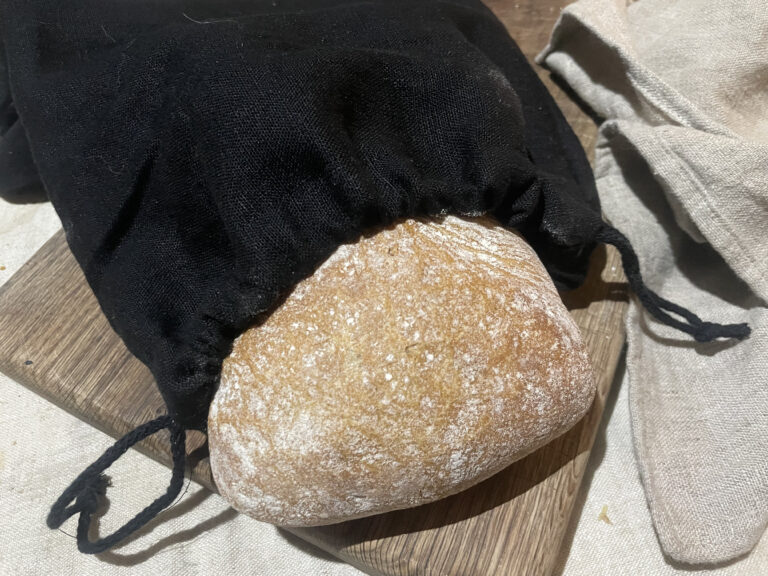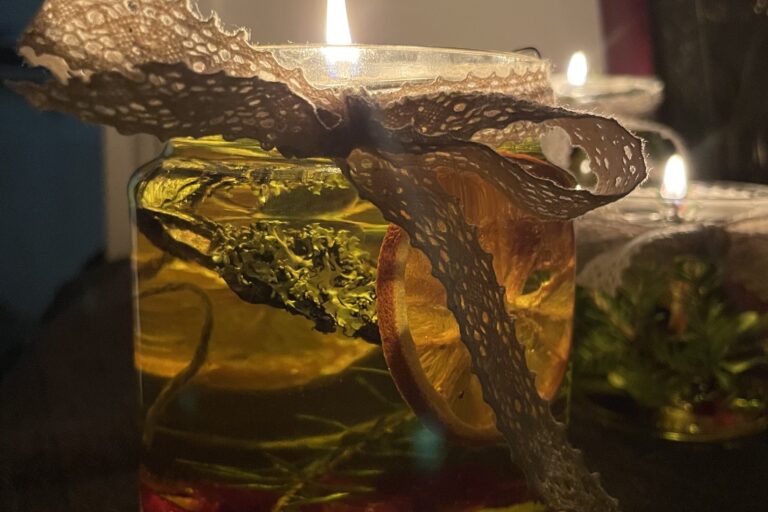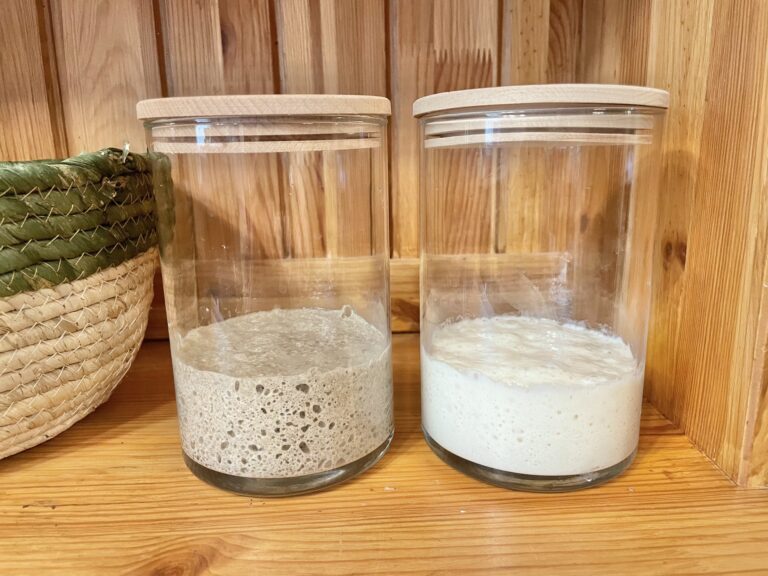When I was expecting my first child, I knew I wanted to start cloth diapering. It feels so nice to think that I can put something natural and skin-friendly against my baby’s skin. Not to mention the money saved and the environment protected. I started using flat diapers immediately after my baby was born, and folding the diaper myself and wrapping it around him is a particularly pleasant feeling. I feel like I’m taking good care of my baby.

Before you start reading, come and follow me on Instagram, Facebook, and Pinterest!
Starting With Flat Diapers
When I started researching how to use cloth diapers, there was initially a lot of confusion. It seemed like the world of cloth diapers was so wildly complicated and there were endless types of diapers. Read more about the different types of cloth diapers to create clarity in all of this.
In the end, I decided to go with gauze flat diapers. I emphasize again that the material of the flat diaper doesn’t necessarily have to be gauze, it can be any natural fabric: organic cotton or linen. You may use even an old shirt or flour sack towels. My mother used gauze diapers, and as a result, we had a large roll of gauze fabric left over from years ago, so I could sew flat diapers for my little one from it, here is the tutorial.
When using any type of cloth diaper, you need to learn a few tricks and tips, which initially seem overwhelmingly many, but the matter will become clear in a couple of days – seriously! And I can say with absolute certainty that flat diapers are the best diapers in the world of cloth diapers, at least for me!
Equipment Required For Using Flat Diapers
Although I sewed my kids’ flat diapers myself and did not buy them, there are plenty of excellent quality flat diapers available for purchase online. Online stores also offer all sorts of other cloth diaper accessories.
- Cotton, gauze, muslin, linen, etc. cloths – size at least 80×80 (cm), about 20 pieces for one child. Diapers of this size can be used from the newborn stage until your child is potty trained.
- Waterproof cover, 2-3 pieces. I use wool covers that I treated with lanolin. You may also use PUL cover, I just really like the idea of using natural wool and its properties. In addition, they hardly need washing. I’ll write more about this below.
- Option 1: Snappi fasteners or diaper pins (safety pins), at least two pieces, because one always seems to get lost. So far I have been using snappies for a long time, which are completely safe. Although safety pins have been used for a long time, I still find them terrifying and prefer to use snappi fastener. With an infant, you can do without a fastener because the diaper cover keeps the gauze diaper in place. As the baby becomes more active, it can serve as a good test to attempt putting on the diaper cover without using the fastener and without causing the folded diaper to fall apart. Unfortunately, the diaper falls off quite quickly.
- Option 2: Tie diapers. After quite a long experience using snappies, I started to prefer tie diapers, which allow me to wrap the fabric around the baby securely and easily. I prefer tie diapers over snappi fasteners because they don’t have any sharp parts, the diaper stays in place much better, and tie diapers won’t get lost. Here is a guide on how to sew tie diapers.
- Recommended – Disposable diaper liners. If the baby’s poop becomes hard (after starting with complementary food), it is recommended to use a disposable diaper liner inside a cloth diaper, such as a piece of liner made of bamboo fiber, which can be disposed of in the trash with the poop. This way, you don’t have to dig the poop out of the diaper, which can be messy. However, with runny poop in the newborn stage, there’s nothing to worry about – the washing machine will wash everything off beautifully. Diaper liners aren’t necessary to use every time, but only when there is a feeling that poop might be coming. Still, it’s always better to be safe than sorry!
- Recommended – A breathable laundry basket or diaper pail for used diapers. Special diaper pails are sold to keep cloth diapers from smelling, but I use a regular woven laundry basket with cotton fabric inside to prevent any staining. Washing cloth diapers is quite easy. I’ve never used any special detergents or washing techniques for cloth diapers. It’s recommended to wash diapers separately from other clothes, but I’ve washed them together with other laundry as well. However, it’s important not to wash newborn diapers with regular laundry because the yellowish liquid stool stains are tough to remove and can easily soil the clothes!

Using Cloth Diapers at Night
You can also use cloth diapers at night. Babies who are heavy wetters might need to change their diapers at night, but I’ve managed just fine without changing. Babies as young as a few months old start to grasp the concept that the diaper becomes wet and uncomfortable when they pee, which not only helps in preventing nighttime wetting but also contributes to their potty training.
Also, adding extra absorbency with diaper inserts is very helpful. These are most commonly used inside pocket diapers, but they can also be used effectively with flat diapers. I’ve used absorbent inserts when I know I can’t change the baby’s diaper for a long time and don’t want it to leak. I have wool diaper inserts at home, which are also treated with lanolin, just like the wool diaper cover. Despite that, inserts come in various materials, sizes, and shapes. If you don’t have inserts, you can simply use pad fold to turn a flat diaper into a rectangular diaper insert.
Using Wool Pants as a Diaper Cover
In my opinion, a wool cover is a great option for waterproof diaper covers. If someone is skilled at knitting, they can even make these themselves (it should be a double layer). Wool covers are available in various sizes, and I purchased size 68 for my newborn. Around 9-10 months, I felt the need to switch to a larger size. However, I managed perfectly well with the same size throughout that time. You don’t need many pairs of wool covers – two are sufficient for one child. But, of course, it’s more convenient to have more, as there have been rare occasions when one pair doesn’t dry in time for reuse.
Wool Cover Care
A wool cover is not waterproof on its own, so we need help from lanolin. Lanolin makes them waterproof and, most importantly, neutralizes urine. Therefore, wool covers hardly ever need washing. Wool items coated with lanolin can be cleaned by airing them out after getting wet with urine. If the wool pants get soiled with poop, they can be easily rinsed and cleaned by hand. So far, I have never washed wool pants in the washing machine (I have used them hundreds of times) and there is no urine smell. I didn’t believe in this urine neutralization at first, but it works 100% well. And from the little moisture that occurs during one diaper change, the pants dry nicely within 1-2 hours. Lanolin should be applied to the pants when they have been washed a lot and it seems that the pants are no longer waterproof. I think I have applied lanolin once every six months. So, in general, wool covers do not need much care.

Tips and Tricks
- Be sure to use a waterproof outer layer in addition to the flat diaper! Cotton flat diapers alone can hold a maximum of 1-2 smaller pee. In addition, the flat diaper comes loose without a cover if the baby wriggles around.
- At the very beginning, the cotton cloth let pee through pretty quickly (even with a cover), so I was completely discouraged. However, I still kept trying it and soon found out that with every wash, the cotton fabric became more and more absorbent. Leaks were soon a thing of the past. So, keep in mind that at first, the pants may be wet, but with a few washes, the fiber becomes super absorbent! If you don’t want wet pants, you can just wet the fabric under the tap and let it dry a few times.
- Gauze or linen dries quickly, and under good conditions, a single flat diaper has even dried in just 15 minutes.
- A flat diaper and wool pants may seem like a big, thick, and hot set on the baby’s thighs, but they are incredibly breathable. I have used flat diapers and wool pants even on 30+ °C (86+ °F) summer days, and there have been no complications or diaper rash.
- Dirty diapers can sit in the laundry basket for about 3-5 days, but after that, the pee can start to smell. Generally, however, the diapers run out before that, and you just have to wash them.
- I change the diaper about every 2-3 hours, and sometimes more frequently when the wool pants are already damp. Since urine can corrode the skin and cause rash, it is not good to keep it on all day, but generally, the diaper gives a very clear signal when it has been on for too long – it just starts leaking.
- Instead of wet wipes, I use cotton cleaning wipes of about the same size, which I wash together with the diapers. There should be about 30 per child of them. In addition to cleaning the bottom, they are also good for cleaning up smaller vomit or wiping mouths clean of food. You can simply wet them with water before use, and they don’t have that strange smell that wet wipes have.
- It’s a good idea to have a wet bag to make using cloth diapers as convenient as possible when you’re away from home.

Folding a Flat Diaper
There are so many different ways to fold flat diapers, such as the kite fold, jelly roll fold, newspaper fold, angel wing fold, bikini fold, airplane fold, and many more. Folding flat diapers requires some practice, but it becomes clear within a few days. If you aren’t so into folding, you may also use prefold cloth diapers. I have familiarized myself with various folding methods and found that the classic origami fold (also called the bat fold) which is one of the most popular folds over time, is the easiest, fastest, and, most importantly, it works most effectively for both infants and toddlers. We want the diaper to have a wide section around the baby’s bottom so that the poop stays in the diaper. At the same time, there should be as many absorbent layers as possible in the middle of the diaper to prevent leaks. The origami fold provides us with both of these. I will try to show step by step how to fold the diaper and put it on the baby.
Origami Fold
1. Place the diaper in front of you.
2.-3. Fold the diaper in half by bringing the bottom up, then folding from right to left. All the loose corners should be in your left hand.
4.-5. Fold the upper layer into a triangle by lifting the top corner to the right.
6. Flip the diaper over. Before, the back of the diaper was facing you, but now the front is facing you.
7.-8. Fold the square section into thirds. This is the area that will absorb the pee. As I mentioned earlier, if your baby is a heavy wetter, you can fold an additional flat diaper into thirds and place it on top for added absorbency.
I’m sure some of you might be sighing and thinking that this sounds too complicated. However, using flat diapers is surprisingly easy, and you’ll get the hang of it in no time! While it may seem like there are many steps involved, it’s not as daunting as it appears.






